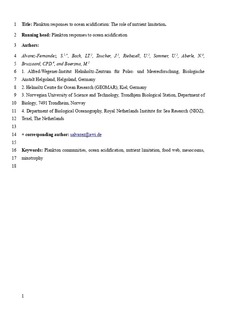| dc.contributor.author | Santiago, Alvarez-Fernandez | |
| dc.contributor.author | Lennart T., Bach | |
| dc.contributor.author | Jan, Taucher | |
| dc.contributor.author | Ulf, Riebesell | |
| dc.contributor.author | Ulrich, Sommer | |
| dc.contributor.author | Aberle-Malzahn, Nicole | |
| dc.contributor.author | Corinne P.D., Brussaard | |
| dc.contributor.author | Maarten, Boersma | |
| dc.date.accessioned | 2019-07-09T10:29:21Z | |
| dc.date.available | 2019-07-09T10:29:21Z | |
| dc.date.created | 2018-04-20T10:56:28Z | |
| dc.date.issued | 2018 | |
| dc.identifier.citation | Progress in Oceanography. 2018, 165 11-18. | nb_NO |
| dc.identifier.issn | 0079-6611 | |
| dc.identifier.uri | http://hdl.handle.net/11250/2603888 | |
| dc.description.abstract | In situ mesocosm experiments on the effect of ocean acidification (OA) are an important tool for investigating potential OA-induced changes in natural plankton communities. In this study we combined results from various in-situ mesocosm studies in two different ocean regions (Arctic and temperate waters) to reveal general patterns of plankton community shifts in response to OA and how these changes are modulated by inorganic nutrient availability. Overall, simulated OA caused an increase in phytoplankton standing stock, which was more pronounced in smaller-sized taxa. This effect on primary producers was channelled differently into heterotroph primary consumers depending on the inorganic nutrient availability. Under limiting conditions, bacteria and micro-heterotrophs benefited with inconsistent responses of larger heterotrophs. During nutrient replete periods, heterotrophs were in general negatively affected, although there was an increase of some mesozooplankton developmental stages (i.e. copepodites). We hypothesize that changes in phytoplankton size distribution and community composition could be responsible for these food web responses. | nb_NO |
| dc.language.iso | eng | nb_NO |
| dc.publisher | Elsevier | nb_NO |
| dc.rights | Attribution-NonCommercial-NoDerivatives 4.0 Internasjonal | * |
| dc.rights.uri | http://creativecommons.org/licenses/by-nc-nd/4.0/deed.no | * |
| dc.title | Plankton responses to ocean acidification: The role of nutrient limitation | nb_NO |
| dc.type | Journal article | nb_NO |
| dc.type | Peer reviewed | nb_NO |
| dc.description.version | acceptedVersion | nb_NO |
| dc.source.pagenumber | 11-18 | nb_NO |
| dc.source.volume | 165 | nb_NO |
| dc.source.journal | Progress in Oceanography | nb_NO |
| dc.identifier.doi | 10.1016/j.pocean.2018.04.006 | |
| dc.identifier.cristin | 1580587 | |
| dc.description.localcode | © 2018. This is the authors’ accepted and refereed manuscript to the article. Locked until 7.5.2020 due to copyright restrictions. This manuscript version is made available under the CC-BY-NC-ND 4.0 license http://creativecommons.org/licenses/by-nc-nd/4.0/ | nb_NO |
| cristin.unitcode | 194,66,10,0 | |
| cristin.unitname | Institutt for biologi | |
| cristin.ispublished | true | |
| cristin.fulltext | original | |
| cristin.qualitycode | 1 | |

